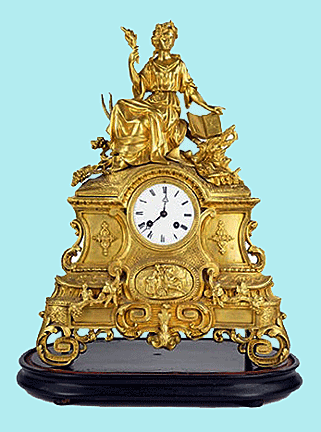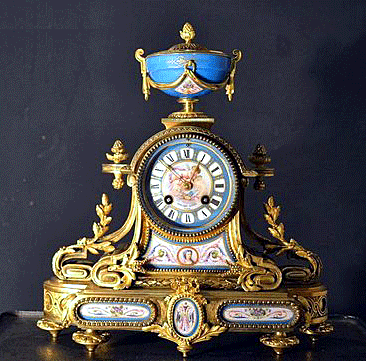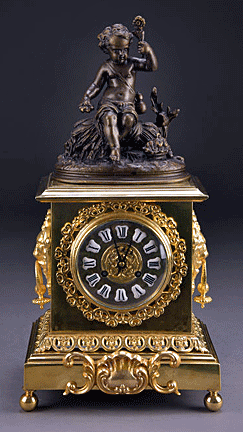|
 French
clockmaking came into its own in the 17th century, when highly
ornamented clocks covered in gilt bronze, known as ormolu, were produced
to keep pace with the new standards for opulence set by King Louis XIV’s
Palace of Versailles. French
clockmaking came into its own in the 17th century, when highly
ornamented clocks covered in gilt bronze, known as ormolu, were produced
to keep pace with the new standards for opulence set by King Louis XIV’s
Palace of Versailles.
There were two general styles of antique French clocks during this
period. One was known as boulle, which refers to a clock cased in
tortoiseshell and inlaid with brass, pewter, porcelain, and ivory. The
second type was called religieuse, in which brass and pewter
overlays were set in ebony veneers on oak.
18th-Century Clocks
During the Regency period from about 1715 to 1723, bracket clocks, which
had been popular a century before, came back into use. These clocks
could be hung on a wall or placed on a table, making them a flexible
timepiece compared to the longcase clocks that clockmakers were also
producing at that time. Rococo pendule, for pendulum, clocks
featured curvaceous profiles and seemingly endless decorative detailing.
 From
1775 on, a new art movement, Neoclassicism, influenced the style of
French clocks. The This style originated as a reaction to the excesses
of the Rococo and through the popularity of the excavations at ancient
Herculaneum and Pompeii, in Italy. Clockmakers did without the excessive
ornamentation and overelaborate designs of the preceding Rococo style so
typical of the Louis XV reign. From
1775 on, a new art movement, Neoclassicism, influenced the style of
French clocks. The This style originated as a reaction to the excesses
of the Rococo and through the popularity of the excavations at ancient
Herculaneum and Pompeii, in Italy. Clockmakers did without the excessive
ornamentation and overelaborate designs of the preceding Rococo style so
typical of the Louis XV reign.
Clocks produced during the reign of Louis XVI and the French First
Republic incorporated classical designs, allegories and motifs. In the
case of the Louis XVI pieces, clockmakers combined white marble,
alabaster, or biscuit with gilded and/or patinated bronze. While some
clocks were more architectural in design, others displayed
classical-style figurines.
 By
the time Louis the XVI assumed the throne 1774, clockmakers were
producing highly accurate regulators, skeleton clocks whose exposed
works were protected from dust by glass domes, and mantel clocks
festooned with everything from bronze Greek and Roman statuary to
cherubs. By
the time Louis the XVI assumed the throne 1774, clockmakers were
producing highly accurate regulators, skeleton clocks whose exposed
works were protected from dust by glass domes, and mantel clocks
festooned with everything from bronze Greek and Roman statuary to
cherubs.
This was also the era of cartel, or frame, clocks. Housed in elaborate
cast-bronze or gold-leaf-on-wood frames, these French wall clocks often
featured Roman numerals on white dials surrounded by gilt garlands and
figurines. One of the many makers of these sorts of clocks was Frederick
Japy, whose firm Japy Freres would become the leading French clockmaker
in the 19th century.
 The
French wall clocks from this period became known as oeil de boeuf,
or bull's eye clocks. Some had movements that were versions of the
Pendule de Paris, the movements found in marble and standard French
mantel clocks. These clocks, most with a flower shape, were often
decorated with mother of pearl and had lift-up fronts. The
French wall clocks from this period became known as oeil de boeuf,
or bull's eye clocks. Some had movements that were versions of the
Pendule de Paris, the movements found in marble and standard French
mantel clocks. These clocks, most with a flower shape, were often
decorated with mother of pearl and had lift-up fronts.
Until the end of the 18th century, the French clockmaking industry had
been centered in the Jura region because of its nearness to the Swiss
and the German clockmaking industries in the Black Forest and the
skilled craftsmen who worked there. In the early 19th century, a couple
of clockmakers moved closer to Paris, where they made standard mantel
clock movements. One moved to Saint-Nicholas-d'Aliermont, which was
attractive because like Jura, it offered a pool of local craftsmen.
The black marble cases used by French clockmakers were assembled in
Rance, using marble from the Dinant area. This practice changed
slightly, however, when Belgium became independent— the French grabbed a
piece of the Dinant marble fields and imposed import tariffs to
undermine the industry in Rance.

 During
the 1790s, the production of gilded-bronze increased considerably as
working conditions became easier. The freedom of trade initiated by
the French Revolution allowed many casters, who during the ancien
régime worked in workshops strictly limited to making bronze, to
develop large factories. They took advantage of this opportunity to
execute all stages of bronze making within one factory and drew,
cast, gilded, assembled and sold objects from their own workshops.
Artisans still benefitted from pre-Revolution training and worked
according to the standards of a luxury art from the ancien régime,
but they had better means of production and organization. During
the 1790s, the production of gilded-bronze increased considerably as
working conditions became easier. The freedom of trade initiated by
the French Revolution allowed many casters, who during the ancien
régime worked in workshops strictly limited to making bronze, to
develop large factories. They took advantage of this opportunity to
execute all stages of bronze making within one factory and drew,
cast, gilded, assembled and sold objects from their own workshops.
Artisans still benefitted from pre-Revolution training and worked
according to the standards of a luxury art from the ancien régime,
but they had better means of production and organization.
Towards the end of the 18th century, round clock movements became a
reliable mass- produced product. Known as Pendule de Paris,
or Paris or French clock movements, they were an 8-day movement with
an anchor escapement, silk-thread suspended pendulum with a count
wheel striking on a bell every hour and half-hour.
19th-century Clocks
 In
the 1800s, Gothic revivalism swept France, and French antique clock
cases began to resemble Gothic cathedrals. Other clocks featured
objects animated by the clock’s movement. Some of these even
incorporated a music box to give the clock and its animated elements
its own soundtrack. In
the 1800s, Gothic revivalism swept France, and French antique clock
cases began to resemble Gothic cathedrals. Other clocks featured
objects animated by the clock’s movement. Some of these even
incorporated a music box to give the clock and its animated elements
its own soundtrack.
The first decade and a half of the 19th century ushered in the
French Empire style of the Napoleonic Empire. Clockmakers continued
to produce elaborately decorated mantel clocks throughout the
Bourbon Restoration from 1814 to1830.
Although there were a great diversity of case shapes, the most
common and popular ones were the clocks with a rectangular or oblong
base sustained by four or more legs of different forms and patterns.
Clockmakers usually decorated the pedestal front with either
garlands, acanthus tendrils, acroterions, laurel wreaths, scrolls,
flowers and other classical decorative motifs, or depicted finely
chased mythological and allegoric scenes in relief as a frieze of a
Greek-Roman temple. On top of the base, in the center or to one
side, sat the plinth that accommodated the clock dial, however in
other models it was also placed in cart wheels, rocks, shields,
globes, tree trunks, and such.
 They
embellished these mantel clocks with fine bronze figures of art,
sciences, and high ideals allegories, gods, goddesses, muses,
cupids, classical literary heroes and other allegorical or
mythological compositions. Sometimes historical personages such as
Alexander the Great, Julius Caesar, George Washington, Napoleon
Bonaparte, philosophers and classical authors, were the main theme
as well. Hence they are also known as figural or sculptural clocks. They
embellished these mantel clocks with fine bronze figures of art,
sciences, and high ideals allegories, gods, goddesses, muses,
cupids, classical literary heroes and other allegorical or
mythological compositions. Sometimes historical personages such as
Alexander the Great, Julius Caesar, George Washington, Napoleon
Bonaparte, philosophers and classical authors, were the main theme
as well. Hence they are also known as figural or sculptural clocks.
Classical sculptures and paintings also inspired clockmakers. The
classical gods served as models and symbols for the era. For
instance, the chariot clocks or pendules au char were an
exceptional category within the Empire clocks. Apollo, Diana and
Cupid depicted as triumphant chariot drivers, were the most popular
gods used. It was habitual during the Napoleonic times and
particularly under the "Directoire" and "Consulat" regimes that
clocks glorify the conduct of warfare.
By the 1850s, clockmakers produced two types of French clocks in
large numbers. They made mantel clocks from 1850 for both the local
and English markets. The design of the English versions was
naturally more sober than the bronze ormolu, white-marble base,
porcelain dial, and gold-handed clocks made by clockmakers such as
Raingo Freres for French customers.
20th-Century Clocks
At the turn of the 20th century, French clockmakers incorporated the
aesthetics of Art Nouveau and Arts and Crafts into their finished
products, but they really shined during the Art Deco Period.
Clockmakers regularly produced mantel clocks made of marble, onyx,
brass, glass, and chrome. Many of these clocks featured columns on
their sides and Roman numerals on their dials.

Figurines and statues, which had been favorite devices of French
clockmakers in the 18th and 19th centuries, continued to flank the
faces of French clocks during the Art Deco era. Bronze human forms
from myth and history were popular, as were animals—from lovebirds
to springboks.
 French
Art Deco clock designers included Edgar Brandt, whose hand-wrought,
forged iron clocks typically sat on marble bases, and Cartier, which
made all sorts of clocks, including square travel clocks with gold
hands and black enameled handles. Compagnie Industrielle de
Macanique Horelogere sold clocks under its JAZ brand. Its line
of Art Deco clocks, introduced in 1934, were usually geometric
(round faces in horizontal cases), colorful (blues, greens, and
gold), and often incorporated mirrors into their designs. French
Art Deco clock designers included Edgar Brandt, whose hand-wrought,
forged iron clocks typically sat on marble bases, and Cartier, which
made all sorts of clocks, including square travel clocks with gold
hands and black enameled handles. Compagnie Industrielle de
Macanique Horelogere sold clocks under its JAZ brand. Its line
of Art Deco clocks, introduced in 1934, were usually geometric
(round faces in horizontal cases), colorful (blues, greens, and
gold), and often incorporated mirrors into their designs.
Unlike the clocks built in the 18th century, the majority of which
were signed, the makers of many of the Empire ones remain anonymous,
making it difficult to attribute one particular work to a certain
bronze sculptor, such as Pierre-Philippe Thomire, Claude Galle,
André-Antoine Ravrio, Louis-Stanislas Lenoir-Ravrio. Experts
consider their timepieces to be works of art—sculptural études,
where the balance in composition and the study of objects, animals
and the human bodies forms and expressions are carefully and
meticulously reflected in the bronze figures, achieving a high
degree of realism, perfectionism and delicacy.
It was a common practice among bronziers to sell pieces to each
other and even to copy or readapt each others' designs. When signed,
they usually bear the bronzier's name as well as the retailer's name
or the movement maker.
< Back
to Clocks Page Go to Clock Care Tips > |
